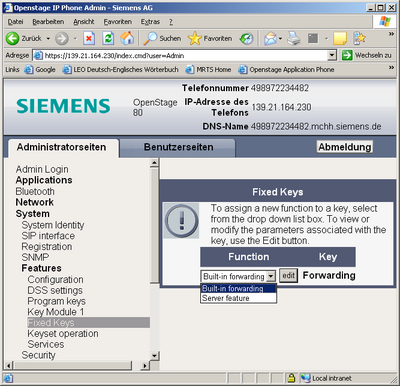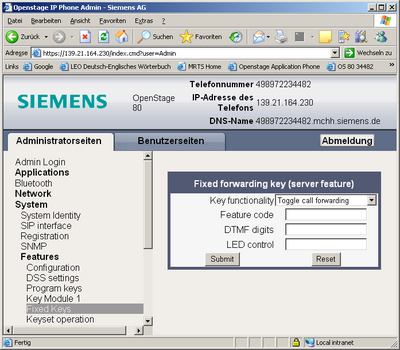Difference between revisions of "Fix Forwarding Key to send URL to Server"
The Wiki of Unify contains information on clients and devices, communications systems and unified communications. - Unify GmbH & Co. KG is a Trademark Licensee of Siemens AG.
(→Accessing the Call Forwarding functionality) |
(→Accessing the Call Forwarding functionality) |
||
| Line 41: | Line 41: | ||
Configuration of the above functionality against the fixed forwarding key will be realised by a new key function and operation parameter related to the key. Configuration of these parameters will be limited to administrators using the [[DLS]] and [[WBM]]. There will be no indication to a user via any mechanism that operation of the fixed forwarding key is configurable. | Configuration of the above functionality against the fixed forwarding key will be realised by a new key function and operation parameter related to the key. Configuration of these parameters will be limited to administrators using the [[DLS]] and [[WBM]]. There will be no indication to a user via any mechanism that operation of the fixed forwarding key is configurable. | ||
| − | [[File:FixForwardingKeytosendURLtoServer-1.png|thumb| | + | [[File:FixForwardingKeytosendURLtoServer-1.png|thumb|400px|left|Fixed Key Setting for Forwarding Key]]<br clear="left"/> |
* '''Built-in Forwarding''': The forwarding key works as known in all previous software versions | * '''Built-in Forwarding''': The forwarding key works as known in all previous software versions | ||
* '''Server Feature''': The forwarding key triggers an external SIP Server for call forwarding | * '''Server Feature''': The forwarding key triggers an external SIP Server for call forwarding | ||
| − | [[File:FixForwardingKeytosendURLtoServer-2.png|thumb| | + | [[File:FixForwardingKeytosendURLtoServer-2.png|thumb|400px|left|Fixed forwarding key settings]]<br clear="left"/> |
== Feature Code == | == Feature Code == | ||
Revision as of 07:27, 22 September 2010
| Systematics | |
| Family: | OpenStage |
| Model: | OpenStage 60 OpenStage 80 |
| Relation: | SIP related |
| Release: | V2 R0 |
This feature description describes the requirement that SIP OpenStage phones with a fixed forwarding key available should be capable of having the key programmed as alternative function to the default built-in forwarding. The primary requirement is for the key to be programmable with a function capable of sending a feature access code to a remote SIP server in order to toggle forwarding; functionality that is currently available on FPKs as the Server Feature key function.
Contents
Current Operation
At present, pressing the fixed forwarding key on a SIP OpenStage phone controls its built-in forwarding functionality. A popup is displayed, allowing the user to both toggle forwarding and edit forwarding destinations. Forwarding state is reflected by a stylised icon and forwarding destination on the Call-View idle screen. The key has two modes of operation:
- Phone based forwarding: Forwarding is performed by the OpenStage Phone. When the user configures forwarding types and destinations, they are stored on the phone. This is the mode of operation when the SIP ‘Server Features’ configuration parameter is set to No.
- Server based forwarding: Forwarding is performed by the SIP Server. When the user configures forwarding types and destinations, a uaCSTA request is sent to the OpenScape Voice de-tailing the new settings. This is the mode of operation when the SIP ‘Server Features’ configuration parameter is set to Yes.
This current operation when the fixed forwarding key is pressed will be packaged as a function definition named Built-in forwarding. This will be the default function allocated to the fixed forwarding key, and will only be programmable against this key.
Call forward toggle functionality using external server
In this configuration, the fixed forwarding key will be programmed as function Server Feature. A new configuration parameter named Key Functionality will be set to Toggle Call Forwarding. The expected purpose of the key will be to toggle forwarding between on and off by sending a feature access code to the server.
Built-in forwarding for either mode of operation as described above will be disabled; any active phone based forwards will be disabled, and server based forwards will remain in their current state. The phone user will not have the ability to make any further changes to either phone or server based built-in forwarding either through the fixed forwarding key or the user menus.
On pressing the key, the user will be presented with prompt Toggle call forwarding, allowing them to accept or reject the action; the prompt will auto-timeout to accept. When accepted, the configured FAC or DTMF sequence will be sent to the external server, as defined in the FD for the Server Feature functionality
Control of the fixed forwarding key LED will be relinquished to the SIP server via a subscription related to the key. The LED state as controlled by the server will be reflected by the visibility of the stylised forwarding icon on the phone’s idle CallView screen. The call forwarding destination will not be displayed.
Call forward functionality using external server, but no toggle functionality assumed
Similarly to above, in this configuration the fixed forwarding key will be programmed as function Server Feature. The Key functionality will be set to Unspecified Call Forwarding. No assumption is made that the key will be used to toggle call forwarding. It is still considered, however, that the functionality of the key will be generally call forwarding related, therefore Built-in forwarding will be disabled, and LED control will be relinquished to the SIP server.
As no toggle functionality is assumed, no prompt to Toggle call forwarding will be shown. Instead, the FAC or DTMF sequence will be immediately sent to the external server, as defined in the FD for the Server Feature functionality. In line with this, no stylised forwarding icon will be displayed on the idle CallView screen.
No functionality assumed
In this configuration, the forwarding key will be programmed as function Server Feature, and the Key Functionality will be set to Unspecified. No assumptions will be made as to the operation of the key. Built-in forwarding will not be disabled. Pressing the key will cause the FAC to be sent immediately to the SIP server, and there will be no UI response either via displaying the call forwarding icon or changing the state of forwarding LEDs. The SIP Server will still have control of the state of the fixed forwarding key LED.
Accessing the Call Forwarding functionality
Configuration of the above functionality against the fixed forwarding key will be realised by a new key function and operation parameter related to the key. Configuration of these parameters will be limited to administrators using the DLS and WBM. There will be no indication to a user via any mechanism that operation of the fixed forwarding key is configurable.
- Built-in Forwarding: The forwarding key works as known in all previous software versions
- Server Feature: The forwarding key triggers an external SIP Server for call forwarding
Feature Code
This code is sent in an INVITE to the given destination, if the phone is idle. The phone will automatically add the configured SIP proxy, if no Domain is given in the URL.
Examples
Feature code: 100
An
INVITE sip:100@192.168.0.10
is sent to 192.168.0.10, if the key is pressed and the phone is idle
Feature code: Allice@192.168.6.100
An
INVITE sip: Alice@192.168.6.100
is sent to 192.168.6.100, if the key is pressed.and the phone is idle.
DTMF Digits
These digits are sent, when the phone is in an call state. The digits are sent inband or out of band. It depends on the configuration.
Example
DTMF digits: 1234#
The DTMF digits are sent, if the key is pressed and the phone is in an call.
LED control
The LED control is done via Dialog event package (RFC 4235), which is the standard Asterisk implemen-tation. The phone will automatically add the configured SIP proxy, if no Domain is given in the URL.
The phone will SUBSRIBE to the given URL. The LED can be controlled over subsequent NOTIFYs.
Examples
LED control: 100
An
SUBSCRIBE sip:100@192.168.010
is sent to 192.168.0.10 after configuration and any startup.
LED control: Allice@192.168.6.100
An
SUBSCRIBE sip: Allice@192.168.6.100
is sent to 192.168.6.100 after configuration and any startup.






